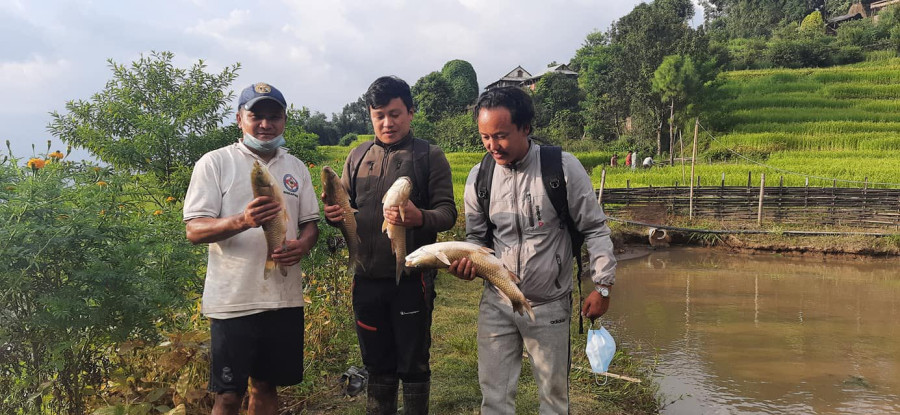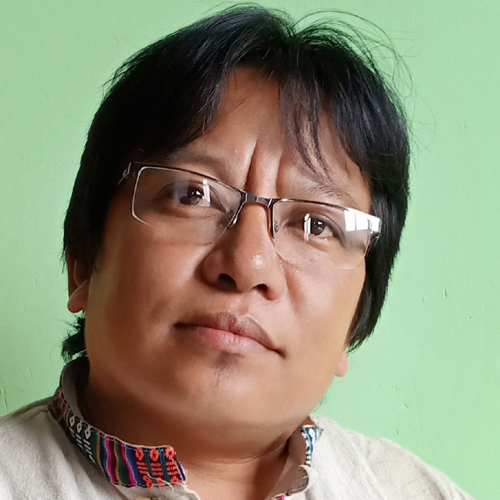Money
Fish farming is catching on in Khotang in eastern Nepal
Many farmers are switching to rearing fish because it provides a higher return compared to other types of farming.
Dambar Singh Rai
Ratanchha village in Khotang district is turning into a fish farming hub with almost every house digging a pond to raise various types of fingerlings.
Many farmers in this hilly district of Province 1 in eastern Nepal are switching to rearing fish instead of planting crops because it pays more.
Sakela Rural Municipality-2, Ratanchha has become a model village as fish ponds can be seen outside most houses. Species like grass carp and common carp are the most common fishes raised here.
Many youths in Ratanchha are making a good income from fish farming, and they are doing it commercially or on a small scale.
Unnat Rai, chairman of Sakela Rural Municipality Ward No 2, is a fish farmer himself. "Youths have been attracted towards fish farming for the last few years as it provides a higher return than the traditional businesses they have been doing for a long time," he said.
An adequate water supply and growing demand for fish has pulled youths towards commercial fish farming, he said. “There are many farmers' youth groups in the villages,” said Rai. He has built fish ponds on his 10 ropanis of land.
Rai sold 60 kg of fish this week, and another 200 kg is ready to be harvested. "Fish production has increased this year.” According to him, fish fetches Rs600 per kg in the local market.
In the last fiscal year, the rural municipality distributed 250,000 fingerlings to local fish farmers in Ratanchha. The financial condition of the villagers has improved after receiving government help, according to locals of Ratanchha.
Fish farmer Parbat Rai has been raising fish for a decade, and has been earning a good income from it. He has reared about 300 kg of fish in his pond this year.
Parbat switched to fishery after seeing that he could make more money this way compared to growing traditional crops. "Fishing is more profitable than other types of farming," he said. "I am preparing to sell 300 kg of fish this year," he said.
The youths of Dhikurtung of Ratanchha have been doing commercial fish farming for the last three years after earning a good income. There are around 13 youth groups who have started commercial fishing by establishing Paurakhi Fish Farming Group in Alele.
The fish reared by the group is ready for the market. Santaraj Rai, secretary of the group, said that one fish weighs about 1.5 kg. "The fish harvest has been good this year too," said Rai. "About a thousand kg of fish will be sold this year," he said.
Arjun Kumar Khadka, chairman of Sakela Rural Municipality, said the rural municipality distributed 250,000 fingerlings in the last fiscal year after observing the people's enthusiasm for fish farming for a long time.
He said the rural municipality decided to distribute fingerlings seeing how keen the local youths were about fish farming.
According to him, rainbow trout farming has been started on the banks of the Tawakhola in Makhmale of Khidima in Sakela Rural Municipality-3.
According to Khadka, a pond is being constructed at a cost of around Rs5 million besides a rainbow trout hatchery. The rainbow trout farm was started with the participation of local groups and local and state governments.
"Work is in full swing, and the rainbow trout farm and hatchery are expected to be ready within this fiscal year," said Khadka.
According to government statistics, Nepal's annual requirement of fish amounts to 172,352 tonnes while local production comes to 83,000 tonnes. The deficit is met by imports.




 8.12°C Kathmandu
8.12°C Kathmandu















